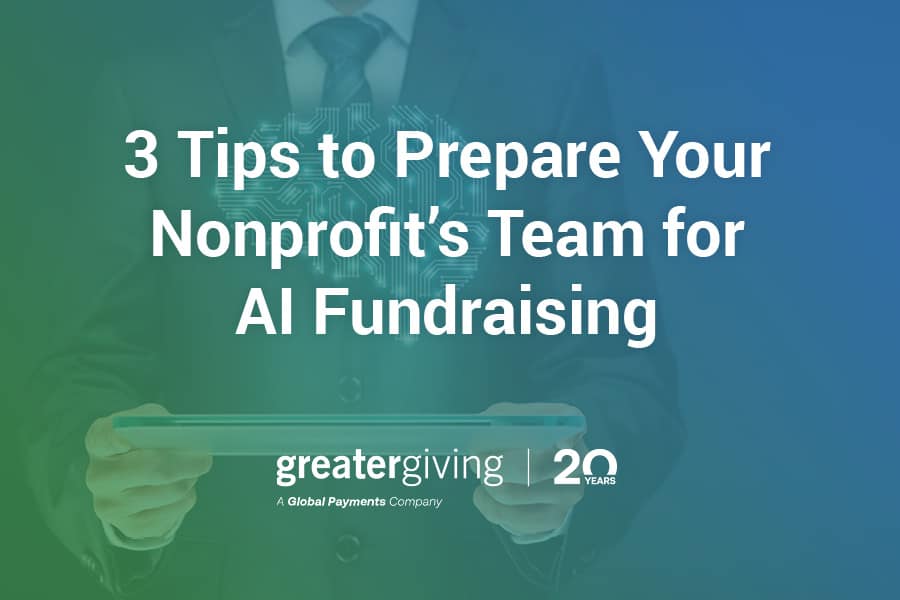
As technology continues to advance, nonprofits are turning to artificial intelligence (AI) to streamline and optimize their fundraising efforts, and for good reason. Predictive analysis, chatbots, and automation have the power to increase fundraising capacity.
However, implementing AI can be a daunting task, especially for teams without prior experience in the field. That’s why we’ve compiled three essential tips to help your team prepare for AI fundraising:
1. Clearly explain the purpose and benefits of AI tools.
2. Conduct staff training.
3. Encourage experimentation.
By leveraging these insights, you can make the most of AI, ultimately leading to increased donations and greater impact. Let’s dive in!
1. Clearly explain the purpose of AI tools.
AI technology can be complex and unfamiliar to many people. Be clear about your intentions to alleviate concerns and foster a better understanding of how you’ll use the technology at your organization.
Begin by defining AI for non-technical team members, explaining that it can perform tasks that typically require human intelligence, such as learning from data, making predictions, or recognizing patterns.
Then, meet with staff, board members, and leadership to establish how you’ll be using AI, whether that be for:
- Donor prospecting: AI-powered prospecting tools prioritize leads based on their propensity and willingness to give, allowing you to focus your fundraising appeals on the most promising prospects.
- Predictive analytics: BWF defines predictive analytics as the process of assessing your nonprofit’s data to make predictions and model future donor behavior. By analyzing historical data, AI models can anticipate future donor behavior and identify potentially valuable fundraising opportunities.
- Online support: Add AI-powered chatbots and virtual assistants to your website to answer frequently asked questions, process donations, and provide donors with round-the-clock support.
- Automated marketing: With AI-powered marketing automation tools, you can automate routine activities, such as email campaigns, social media scheduling, and content creation, to save your team time during the busy fundraising season.
- Fraud detection: Machine learning algorithms can analyze transactional data, donor behavior, and historical records to identify suspicious activities and flag fraudulent donations, helping protect your organization.
It’s important to note that while AI can provide valuable support in these areas, it should not replace your team’s involvement or decision-making. Define what exactly AI will and will not be used for. For instance, your marketing team may use AI to come up with new, creative ideas for blog content, but they should still be in charge of writing it themselves.
2. Conduct staff training.
After introducing the concept and purpose of AI, train staff on how to use the specific tools that they’ll use for fundraising. This includes providing them with educational resources and hands-on training.
You should also host regular training sessions with your team members to review:
- Ethical considerations: AI tools have shortcomings. For instance, an AI-powered prospecting tool may inadvertently prioritize or overlook certain prospects, leading to unequal opportunities for engagement. To mitigate this, work as a group to evaluate AI outputs across different demographic groups and address disparities.
- Security precautions: Emphasize the importance of keeping donor and constituent data safe, whether through encrypting data, limiting access to certain tools, or storing data in a secure database.
- Impact measurement: Have open discussions about the effectiveness of AI and decide how you will monitor its success. For example, if you’re using a chatbot to answer queries on your site, you could measure response time, user satisfaction, and query resolution. Compare these results before and after implementing AI to determine if there are significant improvements.
Training employees on AI best practices will keep their tech skills current and improve their ability to use the technology effectively. Plus, according to NXUnite, offering ongoing training and professional development opportunities is an important employee retention strategy.
3. Encourage experimentation.
Once your team is comfortable with AI, allow them to experiment and innovate. AI is an evolving field, so it’s essential that staff members stay up-to-date and engaged with the technology.
Here are a few areas to give your staff the freedom to experiment:
- Emerging tools and techniques: Have employees play around with tools and techniques relevant to technology-powered fundraising. This will help your organization stay on the cutting edge of the latest trends.
- Workflow optimization: Allow staff to automate day-to-day tasks with AI, such as internal communications, donation processing, and data entry. Then, explore how these tools reduce manual effort and increase operational efficiency.
- Campaign testing: Encourage team members to conduct A/B testing and iterative experiments to optimize AI-driven fundraising campaigns. This involves testing different variables, such as messaging, visuals, or targeting criteria, to identify the most effective approaches.
Create a system for staff members to share insights with fellow team members. For instance, you may dedicate a portion of your AI training meetings to discussing these experiments.
Now is the time to get started with AI fundraising! Remember to prioritize open communication and foster a culture of continual learning so that your staff feels comfortable adapting to new technologies. With the right training and resources, your nonprofit will thrive in a future where AI is the norm.
